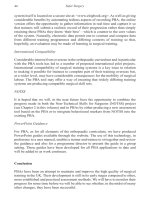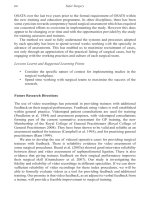Safer Surgery part 2 pps
Bạn đang xem bản rút gọn của tài liệu. Xem và tải ngay bản đầy đủ của tài liệu tại đây (1.16 MB, 10 trang )
Safer Surgery
x
Figure 16.1 The predicted relationship between Behavioral Marker
Risk Index and post-operative complications and
death 272
Figure 18.1 Connection between medical management and the quality
of communication 315
Figure 19.1 Video equipment conguration for orthopaedic surgery
324
Figure 19.2 Mean number of minor failures per operation by type 328
Figure 19.3 Failure source model which links observable minor
failures (small boxes) and common systemic causes
(large boxes) 330
Figure 19.4 Mean rates of threats (top panel) and errors (bottom
panel), with 95 percent condence intervals 331
Figure 19.5 Bland-Altman plot for agreement between two
observers 332
Figure 21.1 A model for the study, with the cues that were available
to participating surgeons 361
Figure 21.2 Cue utilization across individual surgeons 362
Figure 22.1 Study setting in theatres: infant simulator and anaesthesia
work station, anaesthesia nurse (left) and candidate
(right) with the mobile ergospirometry unit applied 373
Figure 22.2 Flow chart for simulated scenario and stress
measurement 374
Figure 22.3 MetaMax 3B
™ 375
Figure 22.4 Candidate with mobile and wireless ergospirometry
device attached 376
Figure 22.5 Salivary cortisol levels during stress (Trier Social Stress
Test, TSST) and rest conditions (Nater et al. 2006) 378
Figure 22.6 Salivary alpha-amylase and norepinephrine (noradrenaline)
in response to stress (Trier Social Stress Test,
TSST) 379
Figure 23.1 Ambulatory electrocardiograms (ECG) and blood pressure
(BP) of an anaesthesiologist during elective (top panel)
and emergency (lower panel) intubations 391
Figure 23.2 Heart rate (HR) and blood pressure (BP) of an experienced
anaesthesiologist obtained by ambulatory monitors
(Holler) 392
Figure 23.3 Comparison of task omission (among those tasks shown
in Table 23.1) 394
Figure 24.1 The distractions–stress ladder 415
Figure 25.1 An iceberg model for observed behaviours 431
List of Tables
Table 2.1 Summary of NOTSS v1.1 evaluation results 16
Table 3.1 PBA domains 30
Table 3.2 Example elements for total hip replacement PBA, taken
from T&O curriculum 31
Table 3.3 Global assessment taken from T&O curriculum 33
Table 3.4 Validation worksheet example taken from T&O curriculum 41
Table 4.1 Index procedures within the surgical specialties 50
Table 5.1 Non-technical skill categories examined in the 13
included papers 69
Table 5.2 Examples of scrub nurse interview questions 73
Table 5.3 Interviewee responses categorized as communication 75
Table 6.1 Operative phases and stages of OTAS
©
88
Table 6.2 Task completion rates in general surgery (rst study)
versus urology (second study) 91
Table 7.1 Summary of rst iteration of the surgical NOTECHS
scoring system 106
Table 7.2 Reliability (R
wg
) of Oxford NOTECHS tool for 36 dual
observed LCs and CEAs 110
Table 7.3 Reliability (R
wg
) of Oxford NOTECHS for 12 dual
observed CEAs 110
Table 7.4 Reliability of Oxford NOTECHS in 14 cases observed
independently with third observer 110
Table 9.1 The A-TEAM scale for assessment of individual team
behaviour 139
Table 10.1 Overview questionnaire communication and teamwork
in operating theatre 157
Table 10.2 Time frame TOPplus project 158
Table 10.3 Duration of the time out (in seconds) 163
Table 10.4 Duration of the debrieng (in seconds) 163
Table 11.1 The ANTS system: categories and elements 177
Table 13.1 Denitions and examples for categories 211
Table 14.1 Intra-observer agreement over time for the observation
system reported at the level of observation categories 231
Table 16.1 Description of domains behavioural markers of team
behaviour assessed by the observers 264
Table 16.2 Denitions of measures: patient risk of complications
(American Society of Anesthesiologists – ASA –
classication), procedure risk (American College of
Cardiologists – ACC-score) and outcome (outcome score) 265
Safer Surgery
xii
Table 16.3 Characteristics of 293 patients and procedures 268
Table 16.4 Description of behavioural markers scores by operative phase,
number and percentage of procedures with complication
or death, and odds ratios (OR) and 95 per cent condence
intervals (CI) for complication or death for less frequent
observation 270
Table 16.5 The association of the Behavioural Marker Risk Index
with post-operative complications and death 271
Table 17.1 Denitions of types of communicative failure with
illustrative examples and notes 285
Table 18.1 Sample of the sample 306
Table 18.2 Category system ‘Problem solving in a team’ 309
Table 18.3 Examples of behavioural markers for evaluating
communication in the scenarios used 310
Table 18.4 Items for evaluating medical management (Scenario 1) 311
Table 18.5 Formal characteristics of utterances in the scenarios 312
Table 18.6 Utterances related to team coordination and shared
mental models 313
Table 18.7 Utterances related to the team and the problem-solving
process 314
Table 19.1 Phases of a typical primary total knee replacement
operation 323
Table 19.2 Descriptions and examples of minor failure types 325
Table 20.1 Selected estimations of frequency of prospective memory
based situations in medicine (mean count), error
proneness of situations (mean %), and valid number
of estimations for each situation (n) 347
Table 21.1 Non-technical skills in the rst simulation series 364
Table 22.1 Reference intervals for plasma and salivary cortisol 378
Table 23.1 Task sequence tracheal intubation where X = cross, SpO
2
= O
2
saturation, BP = blood pressure, HR = heart rate,
IV = intravenous, CO
2
= carbon dioxide 393
Table 23.2 Monitors used: number of patients (%) of total n=48 at each
level of airway management task urgency. Emergency
= <10 mins after admission, semi-emergency < 10–60
mins after admission and elective = > 1 hour after
admission 394
Table 23.3 Task durations of intubation events. Mean and standard
error of duration (in secs) of events in the intubation
sequence among 11 elective and 12 emergency tracheal
intubation 395
Notes on Contributors
Sonal Arora is a doctor of medicine and a trainee in general surgery, with a
further degree in psychology. Her research interests include surgical education and
training for patient safety, with a focus upon simulation and non-technical skills
training. She is currently completing her PhD, entitled ‘Stress, Safety and Surgical
Performance.’
Bianca Balvert is an OR-nurse specialized in endoscopic surgery in Sint Lucas
Andreas Hospital in Amsterdam. She graduated having studied the improvement
of OR patient tracking efciency. She is involved in a patient safety project in
collaboration with Erasmus MC.
Jonathan Beard is a consultant vascular surgeon at the Shefeld Vascular Institute,
Professor of Surgical Education at the University of Shefeld and Education Tutor
at the Royal College of Surgeons of England. He has published widely on surgical
skill assessment and helped to develop the Intercollegiate Surgical Curriculum
Project.
Doug Bonacum is vice president – safety management for Kaiser Permanente. He
leads the development, implementation and monitoring of programme-wide safety
management strategies and plans with specic responsibilities for environmental,
health and safety, patient safety and clinical risk management. He was formerly
responsible for weapons and ships safety as well as nuclear power plant operations
in the US Submarine Force.
Benno Bonke is an associate professor of medical psychology at Erasmus
University Centre, Rotterdam and was trained as a clinical psychologist and
psychotherapist. He is the coordinator of medical education in communication
skills and professional behaviour in the core curriculum in Rotterdam. B.Bonke@
Erasmusmc.nl
John Brookey is assistant medical director of quality for Southern California
Permanente Medical Group, a large multi-specialty group that provides care for
over three million Kaiser Permanente health-plan members. He is a paediatrician
and practises at the Kaiser Permanente Pasadena Medical Ofce. john.brookey@
kp.org
Cornelius Buerschaper is a management consultant and human factors
psychologist specializing in crisis management. He is a team trainer for medical and
Safer Surgery
xiv
managerial teams using computer simulated games for safety training and is
co-author of Crisis Management in Acute Care Settings: Human Factors and
Team Psychology in a High Stakes Environment (2007). cornelius.buerschaper@
t-online.de
J. Forrest Calland is an assistant professor of surgery in the University of Virginia
School of Medicine. His research focuses on outcomes, safety and human factors
in high risk
Ken Catchpole is a human factors practitioner in the QRSTU, Nufeld Department
of Surgery, University of Oxford. Taking a semi-ethnographic approach to
understanding the complex nature of error in healthcare, he seeks to evaluate and
improve the safety of surgical systems.
Jim Crossley is senior fellow in the Academic Unit of Medical Education at the
University of Shefeld and a consultant paediatrician in Chestereld. He advises
and publishes widely on workplace-based assessment and psychometrics.
Trevor Dale is a human factors training specialist and retired airline training
captain. With Guy Hirst he is working with the NHS Institute, The Royal College
of Surgeons of England and Oxford University Nufeld Department of Surgery.
Connie Dekker-van Doorn is an RN with a degree in HRD. She is now working
on her PhD in collaboration with Delft University of Technology focusing on
patient safety and human factors.
Peter Dieckmann is a work and organizational psychologist working with the
Danish Institute for Medical Simulation (DIMS) at the Copenhagen University
Hospital in Herlev, Denmark. Peter studies the use of simulations for training and
research focusing on human factors studies and training of simulation instructors.
John Duncan is a consultant general and vascular surgeon at Raigmore Hospital,
Inverness. He is Clinical Tutor and member of the Specialist Advisory Board in
General Surgery for the Royal College of Surgeons of Edinburgh. john.duncan@
haht.scot.nhs.uk
Christoph Eich is consultant paediatric anaesthetist and co-director of the Centre
for Education and Simulation in Anaesthesiology, Emergency and Intensive Care
Medicine at University Medical Centre Göttingen (Germany).
goettingen.de
Li Felländer-Tsai is a professor and senior consultant in orthopaedic surgery.
She is the chairperson of the Department of Clinical Science, Intervention and
Notes on Contributors
xv
Technology (CLINTEC) at Karolinska Institutet and the director of the Centre for
Advanced Medical Simulation at Karolinska in Stockholm, Sweden.
Rhona Flin is professor of applied psychology, University of Aberdeen
(www.iprc.ac.uk), and she leads the Scottish Patient Safety Research Network
(www.spsrn.ac.uk). Her research on safety examines leadership, culture, team
skills and decision-making in healthcare and high risk industry.
Kenneth T. Fong is a senior managerial consultant in the Pricing Underwriting
Department for Kaiser Permanente’s Northern and Southern California regions.
David Gaba is a medical doctor (anaesthesiology), Professor of Anaesthesia
and Associate Dean for Immersive and Simulation-based Learning at Stanford
University School of Medicine. He is also a Staff Anaesthesiologist at VA Palo
Alto Health Care System.
Fauzia Gardezi is a clinical research project manager at SickKids Learning Institute
in Toronto and a research consultant with expertise in qualitative methodology and
critical sociology.
Emma Giles is a specialist anaesthetist at Sir Charles Gairdner Hospital in Perth,
Western Australia. She has a strong interest in teaching and assessing anaesthesia
registrars and in patient safety, and is an examiner for ANZCA. emma.k8@gmail.
com
Ronnie Glavin is a consultant anaesthetist at the Victoria Inrmary in Glasgow.
He also carries out various roles for NHS for Education in Scotland (NES). ronnie.
Dawn Goodwin is a social science lecturer in medical education. She teaches
courses on various aspects of science, technology and medicine to both medical
and social science students.
Jodi Graham is a specialist anaesthetist at Sir Charles Gairdner Hospital in
Perth, Western Australia. She is a supervisor of anaesthesia training, and her main
interests are in education and simulation.
Suzanne Graham is director of patient safety for Kaiser Permanente. Suzanne has
served in multiple roles within Kaiser Permanente at the medical centre, regional
and national levels. She has a BSN in nursing as well as Masters degrees in school
health and developmental disabilities from San Francisco State University. Her
doctoral degree is from a combined programme at Baylor, University of Texas,
and University of Houston.
Safer Surgery
xvi
Gudela Grote is professor of work and organizational psychology at the ETH
Zurich, Switzerland. She is Associate Editor of the journal Safety Science and has
consulted on safety management for companies like Swiss Re, Deutsche Bahn AG
and the Swiss Nuclear Inspectorate.
Stephanie Guerlain is associate professor of systems and information engineering
at the University of Virginia, USA. Her research focuses on human–computer
interaction, particularly information visualization, training system design and the
design of decision support systems.
Leif Hedman is a licensed psychologist and associate professor at the Department
of Psychology, Umeå University, expert in medical human factors. He is also
an afliated researcher at the Department of Clinical Science, Intervention and
Technology (CLINTEC) and the Centre for Advanced Medical Simulation at
Karolinska in Stockholm, Sweden.
Guy Hirst founded Atrainability Limited with Trevor Dale in 2002. He recently
retired as a training standards captain from British Airways. Since 2001 he has
been involved in several research projects training multidisciplinary teams in
various healthcare environments.
Graham Hocking is a specialist anaesthetist at Sir Charles Gairdner Hospital,
Perth, Western Australia. His main interests are research, education and regional
anaesthesia.
Gesine Honger is a human factors psychologist specializing in patient safety
and management of critical incidents. She is a member of the advisory board of
the German Coalition for Patient Safety and co-author of Crisis Management
in Acute Care Settings: Human Factors and Team Psychology in a High Stakes
Environment (2007). gesine.ho
Steve Howard is an associate professor of anaesthesia at Stanford University
School of Medicine and a staff anaesthesiologist at the VA Palo Alto Health Care
System.
Robbert Huijsman is part-time professor of management of integrate care at the
department of Health Policy and Management of Erasmus University Rotterdam.
He combines his scientic work with a partnership in a healthcare consultancy
rm (Zorg Consult Nederland).
Rosamond Jacklin is a specialist registrar in general surgery. After graduating
from medical school in 2000, Ros undertook basic surgical training and the MRCS,
then completed a PhD at Imperial College (2004–2008) entitled ‘Judgment and
Decision Making in Surgery’.
Notes on Contributors
xvii
Shelly Jeffcott is a senior research fellow at the NHMRC Centre of Research
Excellence in Patient Safety and has a background in psychology and the
examination of risk and safety in high hazard industries. Shelly.Jeffcott@med.
monash.edu.au
Geert Kazemier is hepatobiliary and transplant surgeon at Erasmus Medical
Centre. He is also responsible for the Operating Room Department at that
institution.
Jan Klein is professor of anaesthesiology at the Erasmus University Medical
Centre. He developed a special interest in peri-operative patient safety and is the
President of the Netherlands Society of Anaesthesiology.
Michaela Kolbe is work and organizational psychologist and research assistant
at the Organization, Work and Technology Group at ETH Zurich, Switzerland.
Barbara Künzle is work and organizational psychologist and research assistant
at the Organization, Work and Technology Group at ETH Zurich, Switzerland.
Johan Lange is professor of surgery in the department of surgery of the Erasmus
University Medical Centre in Rotterdam, the Netherlands. He is Associate Dean of
the Faculty of Medicine of the Erasmus University and President of the Committee
of Patient Safety of the Dutch Society of Surgery.
Robert Lasky is a professor of paediatrics and the director of the Design and
Analysis Support Services for the Centre of Clinical Research and Evidence Based
Medicine at the University of Texas Medical School at Houston. Robert.E.Lasky@
uth.tmc.edu
Lorelei Lingard is senior scientist in the SickKids Research Institute and the Wilson
Centre for Research in Education, University Health Network and University of
Toronto. She is the inaugural holder of the BMO Financial Group Professorship in
Health Professions Education Research.
Colin Mackenzie is professor of anaesthesiology and associate professor of
physiology at the University of Maryland School of Medicine. His research
interests include human factors in emergencies, and trauma resuscitation. He has
been continuously funded by Federal grants for the past 18 years. cmack003@
umaryland.edu
Marlene Dyrløv Madsen works at the Danish Institute for Medical Simulation
(DIMS) as a researcher in patient safety and safety culture. She has a PhD in
Safer Surgery
xviii
patient safety and ethics of patient safety, and holds a Masters in philosophy and
communication.
Tanja Manser is a senior lecturer at the Centre for Organizational and
Occupational Sciences, ETH Zurich, where she is heading a research group on
human performance and safety in complex systems.
Nikki Maran is a consultant anaesthetist in The Royal Inrmary of Edinburgh and
Director of the Scottish Clinical Simulation Centre in Stirling. Her interests are in
anaesthesia for emergency surgery, education for patient safety and non-technical
skills training and assessment.
Joy Marriott is a specialty registrar in obstetrics and gynaecology, currently
working towards an MD in surgical education and a Masters of Education at the
University of Shefeld. Her research interests include workplace assessment and
competency-based selection.
Karen R. Mazzocco is a nurse-attorney with 20 years of experience as a surgical
director, primarily at the University of Cincinnati where she achieved her BSN
and Juris Doctor. She practised law in hospitals in New York and New Mexico.
Since 2001, she worked in research in surgical and perinatal patient safety during
afliations at Kaiser Permanente in California. Currently, she is afliated with
Sharp Healthcare in San Diego, CA, in the evolving eld of patient service and
satisfaction.
Peter McCulloch is clinical reader at the Nufeld Department of Surgery in
Oxford. He founded the Quality, Reliability, Safety and Teamwork Unit (QRSTU)
in 2005, which focuses on evaluating interventions to improve the functionality of
modern healthcare systems.
Lisbet Meurling is specialist in anaesthesia and intensive care medicine and
participant of the Scandinavian Society of Anaesthesiology training programme in
intensive care medicine. She is a PhD student at CLINTEC, Karolinska Institutet.
Ami Mishra is a surgical registrar on the Oxford rotation, whose MD project
examined the value of an aviation-style team training approach to improving
safety in the operating theatre. He hopes to maintain his research throughout and
beyond his training.
Lucy Mitchell is a research assistant in the Industrial Psychology Research
Centre, University of Aberdeen, investigating non-technical skills of nurses/scrub
practitioners. She previously studied police rearms ofcers’ decision-making
skills and was formerly a police ofcer.
Notes on Contributors
xix
Maggie Mort is reader in the sociology of science, technology and medicine
and co-director of the Centre for Science Studies at Lancaster University, UK.
An ethnographer, her research interests include new medical technologies,
telehealthcare and disaster recovery.
Michael Müller is consultant anaesthetist at the Hospital of Technical University
and Director of Interdisciplinary Medical Simulation Centre, Dresden, Germany.
David Musson is an assistant professor and Director of the Centre for Simulation-
Based Learning at McMaster University in Hamilton, Canada. He received his
MD from the University of Western Ontario, and PhD in psychology from the
University of Texas at Austin.
Andrea Nickut is a research student at the Centre for Education and Simulation in
Anaesthesiology, Emergency and Intensive Care Medicine at University Medical
Centre Göttingen (Germany).
Simon Paterson-Brown is a consultant general and upper gastro-intestinal
surgeon at the Royal Inrmary Edinburgh and an honorary senior lecturer at the
University of Edinburgh.
Rona Patey is a consultant anaesthetist at Aberdeen Royal Inrmary. She is also
the Director of the Clinical Skills Centre at Foresterhill and Deputy Head of the
University of Aberdeen Division of Medical and Dental Education. r.patey@abdn.
ac.uk
Diana Petitti is a physician (preventive medicine) and medical doctor (MD) She
is Professor in the Department of Biomedical Informatics in the Fulton School of
Engineering at Arizona State University.
David Pitts is a psychologist with a background in management development.
He is Project Coordinator of the UK orthopaedic curriculum (OCAP), Associate
Director of Leadership and Educational Development at the Royal College
of Surgeons of Edinburgh and Education Advisor to the British Orthopaedic
Association.
Catherine Pope is reader in the school of health sciences, University of
Southampton. Her research includes evaluations of organizational change and
studies of surgical practice. She is currently researching the use of computer
decision support in urgent and emergency care, and ambulance handovers.cjp@
soton.ac.uk









